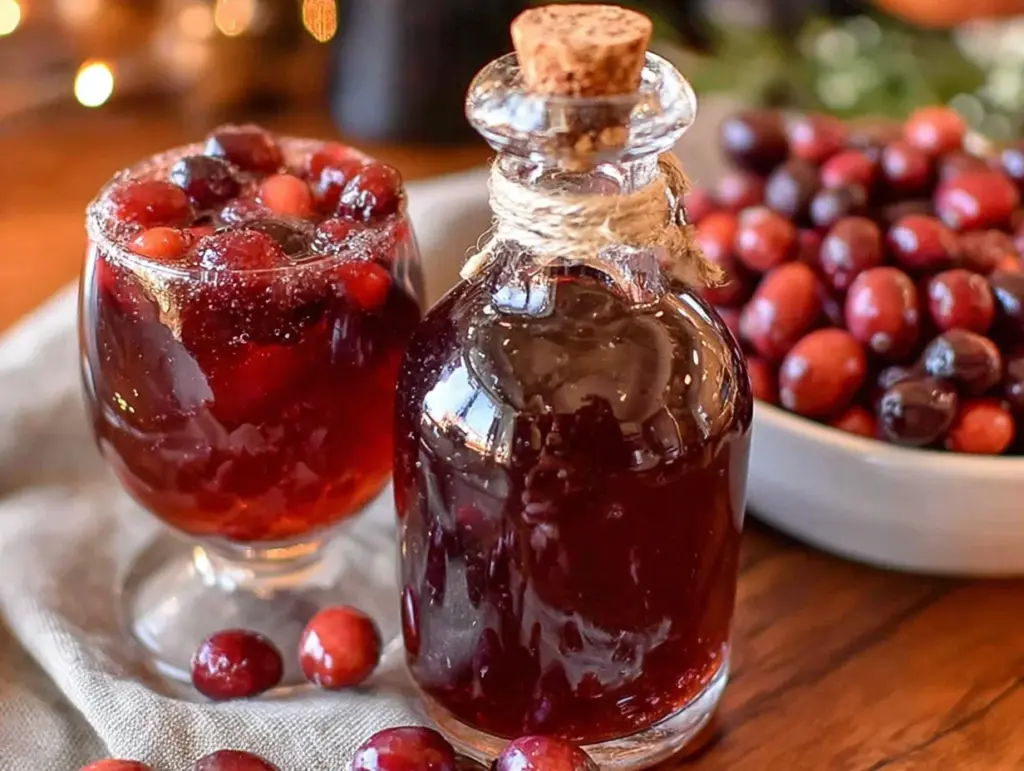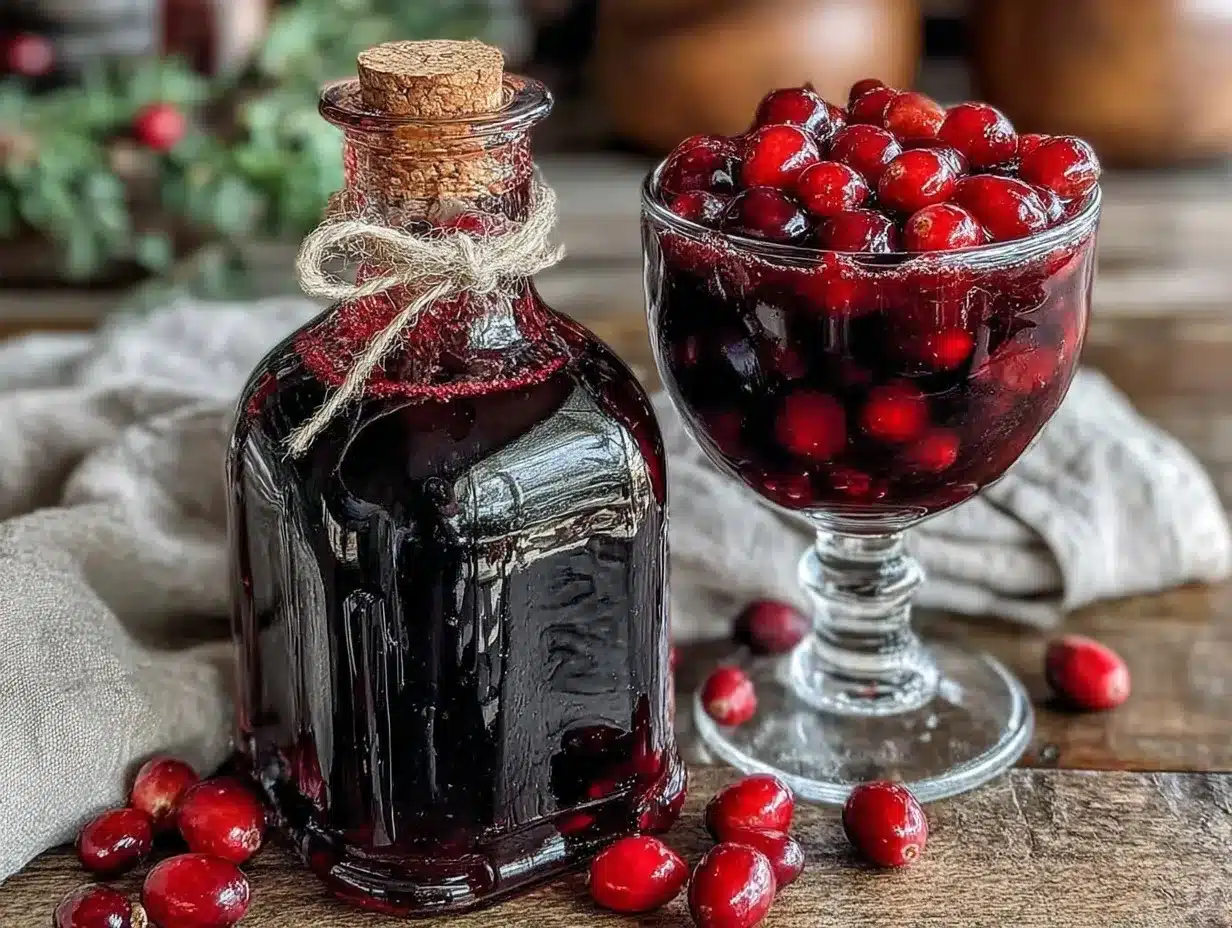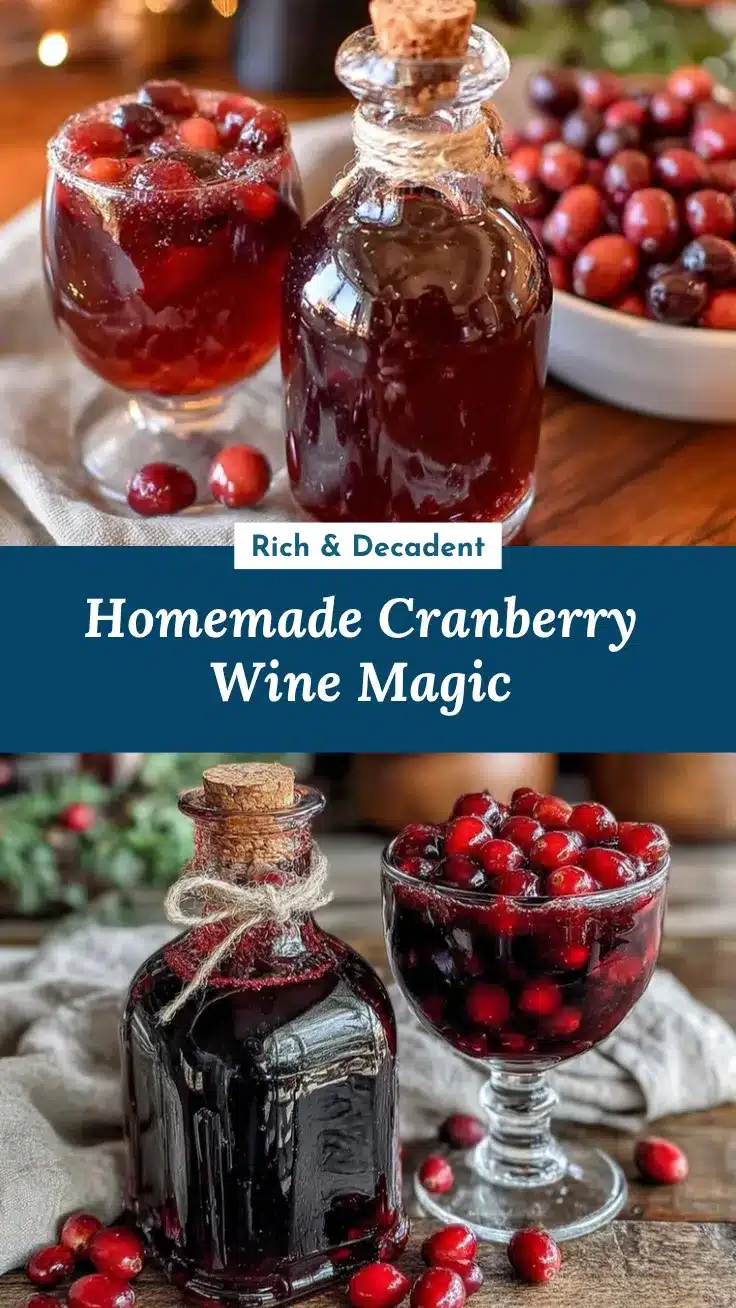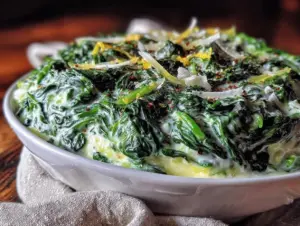There’s something magical about homemade cranberry wine. The tart sweetness of cranberries, blended with sugar and transformed into a rich, ruby-red wine—it’s pure alchemy in a bottle! I first tried making this during the holidays, inspired by the abundance of fresh cranberries at the market. Not only was it a fun project, but the result was beyond my expectations. Every sip was a taste of the holidays, bursting with fruity notes and just the right amount of tang.
This irresistible cranberry wine recipe is perfect for anyone who wants to try their hand at homemade winemaking. Whether you’re a seasoned pro or a curious beginner, this recipe is approachable and gratifying. It’s also an excellent way to impress your dinner guests or create a memorable gift for loved ones. Trust me, once you taste this homemade perfection, you’ll never want to go back to store-bought!
Why You’ll Love This Recipe
- Easy to Make: No fancy equipment or complicated steps—just straightforward, beginner-friendly instructions.
- Budget-Friendly: Making your own cranberry wine is much more affordable than buying bottles from the store.
- Perfect for Holidays: The tart, slightly sweet flavor of cranberry wine pairs beautifully with festive meals and gatherings.
- Customizable: You can tweak the sweetness or even add spices for a unique twist.
- Impressive Results: Friends and family will be amazed that you made such delicious wine from scratch!
What sets this cranberry wine recipe apart is its simplicity combined with big flavor. The cranberries provide a vibrant color and taste, while the fermentation process creates a smooth finish. This isn’t just wine—it’s a handcrafted masterpiece that’s as much fun to make as it is to drink. Plus, there’s something so satisfying about pouring a glass and knowing you made it yourself!
What Ingredients You Will Need
This cranberry wine recipe uses simple ingredients to create a delightful drink that’s perfect for sipping or sharing.
- Cranberries: Fresh or frozen work equally well. Pick ripe and vibrant berries for the best flavor (avoid bruised or mushy ones).
- Granulated Sugar: Helps with fermentation and balances the tartness of the cranberries.
- Water: Filtered or distilled is ideal to ensure clean flavors.
- Lemon Juice: Adds brightness and balances the flavor profile.
- Wine Yeast: Essential for fermentation. Look for a good-quality wine yeast at a homebrew store or online.
- Campden Tablets: Used to sterilize the must and prevent unwanted wild yeast or bacteria from interfering with fermentation.
- Pectic Enzyme: Helps break down the fruit and extract juice while clarifying the wine.
- Yeast Nutrient: Boosts fermentation by providing essential nutrients for your yeast.
- Optional Spices: Cinnamon sticks, cloves, or nutmeg can add a warm, festive touch.
Don’t worry if some of these ingredients sound unfamiliar—they’re easy to find at homebrew shops or online. And for substitutions, you can skip the spices or adjust the sugar level to suit your taste preferences. This recipe is all about customization!
Equipment Needed
To make cranberry wine, you don’t need a professional setup. Here’s what you’ll need:
- Primary Fermentation Bucket: A food-grade plastic bucket with an airlock is perfect for starting the fermentation process.
- Glass Demijohn or Carboy: Used for secondary fermentation and aging.
- Airlock and Bung: Prevents contamination while allowing gases to escape during fermentation.
- Hydrometer: Measures sugar content to track fermentation progress.
- Strainer or Cheesecloth: For filtering the cranberries after fermentation.
- Siphon Tube: Helps transfer the wine between containers without disturbing the sediment.
Pro tip: If you’re new to winemaking, you can often find beginner kits that include most of these items. And don’t worry—this equipment is reusable for future batches, so it’s a great investment if you fall in love with crafting homemade wine!
Preparation Method
- Prepare the Cranberries: Wash the cranberries thoroughly and discard any that are bruised or damaged.
- Crush the Fruit: Use a food processor or mash them manually until they’re broken down but not pureed.
- Make the Must: In your fermentation bucket, combine the crushed cranberries, sugar, and water. Add the lemon juice, pectic enzyme, and crushed Campden tablet. Stir well and let the mixture sit for 24 hours.
- Add the Yeast: Sprinkle the wine yeast over the surface of the must. Add yeast nutrient and gently stir to incorporate.
- Primary Fermentation: Cover the bucket with a lid and attach the airlock. Store in a cool, dark place for 5-7 days, stirring daily.
- Strain the Must: After primary fermentation, strain the liquid into a clean glass demijohn or carboy using a strainer or cheesecloth.
- Secondary Fermentation: Seal the demijohn with an airlock and let the wine sit for 4-6 weeks. Check the hydrometer readings periodically to ensure fermentation is complete.
- Bottle the Wine: When fermentation is finished, siphon the wine into sterilized bottles. Seal tightly and store in a cool, dark place.
Homemade cranberry wine takes patience, but the result is worth every step. Watching the transformation from simple ingredients to a beautifully crafted wine is part of the fun!
Cooking Tips & Techniques
Here are some tips to ensure your cranberry wine turns out perfectly:
- Don’t Rush Fermentation: Allow the wine to ferment fully for the best flavor and alcohol content.
- Sanitation is Key: Sterilize all equipment before use to prevent contamination.
- Monitor Sugar Levels: Use a hydrometer to track the fermentation process and make adjustments if necessary.
- Be Patient During Aging: Cranberry wine improves with time, so resist the temptation to open it too soon!
I’ve learned the hard way that rushing the process can lead to flat flavors or off notes. Take your time, follow each step, and you’ll be rewarded with a delicious homemade wine that’s bursting with flavor.
Variations & Adaptations
Want to put your own spin on this cranberry wine recipe? Here are some ideas:
- Low-Sugar Version: Reduce the sugar by half and add a splash of honey for natural sweetness.
- Spiced Cranberry Wine: Add a cinnamon stick, a few cloves, or star anise to the fermentation for a holiday-inspired flavor.
- Mixed Berry Wine: Swap out half the cranberries for raspberries or blackberries for a unique twist!
Personally, I’ve tried adding a hint of orange zest to the mix—it gave the wine a citrusy zing that paired beautifully with the tart cranberries. Feel free to experiment and make this recipe your own!
Serving & Storage Suggestions
Serve your cranberry wine slightly chilled or at room temperature, depending on your preference. It pairs wonderfully with roasted meats, cheese platters, or even dessert—think chocolate cake or fruit tarts.
For storage, keep unopened bottles in a dark, cool place to preserve flavor. Once opened, refrigerate and consume within 5-7 days. If you’re planning to keep the wine long-term, make sure the bottles are sealed properly to avoid oxidation.
Fun fact: The flavors of cranberry wine often deepen over time, so aging it for a few months can make it even more delightful!
Nutritional Information & Benefits
While cranberry wine is certainly a treat, it also has some surprising benefits:
- Rich in Antioxidants: Cranberries are packed with antioxidants that support overall health.
- Low-Calorie Option: Homemade wine allows you to control sugar levels, making it a lighter choice.
- Gluten-Free: This recipe is naturally gluten-free, so it’s suitable for those with dietary restrictions.
As always, enjoy responsibly and savor the unique flavors this wine has to offer!
Conclusion
If you’re looking for a fun project that results in a delicious, homemade treat, this irresistible cranberry wine recipe is the perfect choice. It’s easy to make, customizable, and guaranteed to impress anyone who tries it.
I love this recipe because it brings people together—whether it’s during the holidays or a casual dinner with friends. Every sip feels special, and knowing you made it yourself adds an extra layer of satisfaction.
So, grab some cranberries and give this recipe a try. I’d love to hear how it turns out—leave a comment or share your own variations below. Cheers to homemade perfection!
FAQs
Can I use frozen cranberries for this recipe?
Absolutely! Frozen cranberries work just as well as fresh ones. Just make sure to thaw them before using.
How long does the fermentation process take?
Primary fermentation usually lasts 5-7 days, while secondary fermentation can take 4-6 weeks. Aging the wine for a few months further enhances the flavor.
Do I need special equipment for this recipe?
You’ll need some basic winemaking tools like a fermentation bucket, demijohn, airlock, and hydrometer. Many of these can be found in starter kits online.
Can I make this recipe without wine yeast?
Wine yeast is recommended for the best results, but you can try substituting with baker’s yeast in a pinch. The flavor may differ slightly.
How should I store homemade cranberry wine?
Keep unopened bottles in a cool, dark place. Once opened, refrigerate and consume within 5-7 days. Properly sealed bottles can be aged for several months or even years!
Pin This Recipe!

Irresistible Cranberry Wine Recipe Easy Homemade Steps
- Total Time: 4-6 weeks + aging time
- Yield: Approximately 5 bottles
Description
A simple and customizable homemade cranberry wine recipe that transforms tart cranberries into a rich, ruby-red wine perfect for holidays or gifting.
Ingredients
- Fresh or frozen cranberries
- Granulated sugar
- Filtered or distilled water
- Lemon juice
- Wine yeast
- Campden tablets
- Pectic enzyme
- Yeast nutrient
- Optional spices: cinnamon sticks, cloves, or nutmeg
Instructions
- Prepare the Cranberries: Wash the cranberries thoroughly and discard any that are bruised or damaged.
- Crush the Fruit: Use a food processor or mash them manually until they’re broken down but not pureed.
- Make the Must: In your fermentation bucket, combine the crushed cranberries, sugar, and water. Add the lemon juice, pectic enzyme, and crushed Campden tablet. Stir well and let the mixture sit for 24 hours.
- Add the Yeast: Sprinkle the wine yeast over the surface of the must. Add yeast nutrient and gently stir to incorporate.
- Primary Fermentation: Cover the bucket with a lid and attach the airlock. Store in a cool, dark place for 5-7 days, stirring daily.
- Strain the Must: After primary fermentation, strain the liquid into a clean glass demijohn or carboy using a strainer or cheesecloth.
- Secondary Fermentation: Seal the demijohn with an airlock and let the wine sit for 4-6 weeks. Check the hydrometer readings periodically to ensure fermentation is complete.
- Bottle the Wine: When fermentation is finished, siphon the wine into sterilized bottles. Seal tightly and store in a cool, dark place.
Notes
[‘Don’t rush fermentation for the best flavor and alcohol content.’, ‘Sterilize all equipment before use to prevent contamination.’, ‘Use a hydrometer to monitor sugar levels during fermentation.’, ‘Aging the wine for a few months enhances its flavor.’]
- Prep Time: 24 hours
- Cook Time: 4-6 weeks
- Category: Beverage
- Cuisine: American
Nutrition
- Serving Size: 1 glass (approximate
- Calories: 125
- Sugar: 12
- Sodium: 5
- Carbohydrates: 15
Keywords: cranberry wine, homemade wine, holiday drink, festive wine, DIY wine, winemaking, cranberry recipe





